
The Book of the 24 Philosophers (Latin : Liber XXIV philosophorum) is a philosophical and theological medieval text of uncertain authorship.

The Book of the 24 Philosophers (Latin : Liber XXIV philosophorum) is a philosophical and theological medieval text of uncertain authorship.
The book consists of twenty-four "sentences", "aphorisms" or "definitions" of God, attributed to as many philosophers attending a fictional gathering, each an attempt to answer their only remaining question, "what is God?" (quid Deus?). The first textual witness is from a 12th-century French manuscript currently at Laon. [1] The definitions were often accompanied by a scholastic commentary in either of two redactions, the "shorter" and the "longer" commentary. Both definitions and commentary echo and weave numerous late ancient and medieval views on the first cause and the nature of divinity. [2]
During the Middle Ages, the Liber was variously attributed to Hermes Trismegistus, Aristotle or simply quoted anonymously by theologians and philosophers. Contemporary scholarship is still inconclusive about the origin and authorship of the text. French scholar Françoise Hudry has argued for the attribution to Marius Victorinus (fl. 4th century). [3] According to others, the text would belong to a lost work by Aristotle, the De philosophia, known to medieval Europe through the Arab translators of the Toledo School.
There are notably German, French and Italian studies of the text available, [4] with no English translation yet in print, although online editions exist. [5]
The influence of this work on medieval scholarship and literature has revealed traces of its ideas among the works of Jean de Meung, Dante, Meister Eckhart, Nicholas of Cusa, Giordano Bruno, Martin Luther, [6] Robert Fludd, Pascal, and Leibniz. [1]
The second definition in particular gained wide currency from early on in the High Middle Ages: “God is an infinite sphere whose centre is everywhere and whose circumference is nowhere” (Deus est sphaera infinita cuius centrum est ubique, circumferentia nusquam). [1]
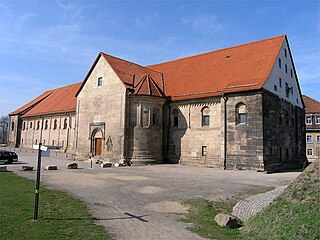
Basil Valentine is the Anglicised version of the name Basilius Valentinus, ostensibly a 15th-century alchemist, possibly Canon of the Benedictine Priory of Saint Peter in Erfurt, Germany but more likely a pseudonym used by one or several 16th-century German authors.
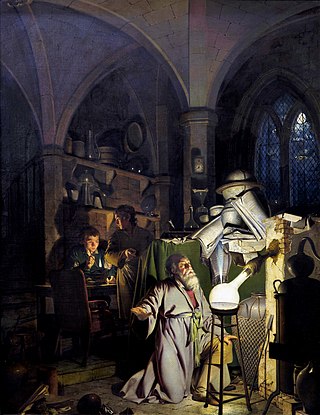
The philosopher's stone is a mythic alchemical substance capable of turning base metals such as mercury into gold or silver. It is also called the elixir of life, useful for rejuvenation and for achieving immortality; for many centuries, it was the most sought-after goal in alchemy. The philosopher's stone was the central symbol of the mystical terminology of alchemy, symbolizing perfection at its finest, divine illumination, and heavenly bliss. Efforts to discover the philosopher's stone were known as the Magnum Opus.
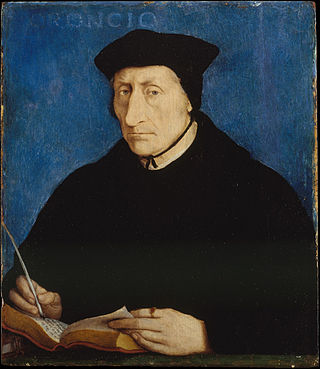
Guillaume Budé was a French scholar and humanist. He was involved in the founding of Collegium Trilingue, which later became the Collège de France.

The Hermetica are texts attributed to the legendary Hellenistic figure Hermes Trismegistus, a syncretic combination of the Greek god Hermes and the Egyptian god Thoth. These texts may vary widely in content and purpose, but by modern convention are usually subdivided into two main categories, the "technical" and "religio-philosophical" Hermetica.

The Emerald Tablet, the Smaragdine Table, or the Tabula Smaragdina is compact and cryptic Hermetic text. It was a highly regarded foundational text for many Islamic and European alchemists. Though attributed to the legendary Hellenistic figure Hermes Trismegistus, the text of the Emerald Tablet first appears in a number of early medieval Arabic sources, the oldest of which dates to the late eighth or early ninth century. It was translated into Latin several times in the twelfth and thirteenth centuries. Numerous interpretations and commentaries followed.
Gaius Marius Victorinus was a Roman grammarian, rhetorician and Neoplatonic philosopher. Victorinus was African by birth and experienced the height of his career during the reign of Constantius II. He is also known for translating two of Aristotle's books from ancient Greek into Latin: the Categories and On Interpretation. Victorinus had a religious conversion, from being a pagan to a Christian, "at an advanced old age".
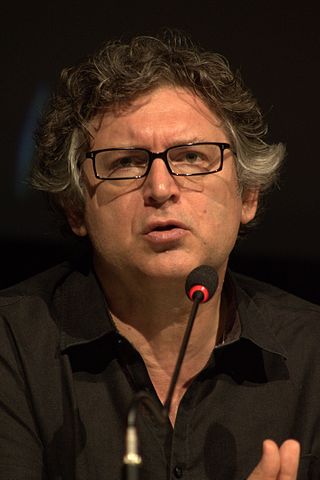
Michel Onfray is a French writer and philosopher with a hedonistic, epicurean and atheist worldview. A highly-prolific author on philosophy, he has written over 100 books. His philosophy is mainly influenced by such thinkers as Nietzsche, Epicurus, the Cynic and Cyrenaic schools, as well as French materialism. He has gained notoriety for writing such works as Traité d'athéologie: Physique de la métaphysique, Politique du rebelle: traité de résistance et d'insoumission, Physiologie de Georges Palante, portrait d'un nietzchéen de gauche, La puissance d'exister and La sculpture de soi for which he won the annual Prix Médicis in 1993.

Thérèse Philosophe is a 1748 French novel ascribed to Jean-Baptiste de Boyer, Marquis d'Argens, or, according to a minority opinion, Denis Diderot and others. It has been chiefly regarded as a pornographic novel, which accounts for its massive sales in 18th-century France. The novel represents a public conveyance for some ideas of the Philosophes.

The Abbey of Saint Victor, Paris, also known as Royal Abbey and School of Saint Victor, was an abbey near Paris, France. Its origins are connected to the decision of William of Champeaux, the Archdeacon of Paris, to retire to a small hermitage near Paris in 1108. He took on the life, vocation and observances of the Canons Regular, and his new community followed the Augustinian Rule.
Radulphus Brito was an influential grammarian and philosopher, based in Paris. He is usually identified as Raoul le Breton, though this is disputed by some. Besides works of grammatical speculation he wrote on Aristotle, Boethius and Priscian.

Charles de Bovelles was a French mathematician and philosopher, and canon of Noyon. His Géométrie en françoys (1511) was the first scientific work to be printed in French.
The Corpus Scriptorum Ecclesiasticorum Latinorum (CSEL) is an academic series that publishes critical editions of Latin works by late-antique Christian authors.

The Liber de causis is a philosophical work composed in Arabic in the 9th century. It was once attributed to Aristotle and became popular in West during the Middle Ages, after it was translated into Latin by Gerard of Cremona between 1167 and 1187. The original title was كتاب الإيضاح لأرسطوطاليس في الخير المحض Kitāb al-Īḍāḥ li-Arisṭūṭālis fī l-khayr al-maḥd, "The book of Aristotle's explanation of the pure good". Its Latin title, Liber de causis, came into use following its translation. The work was also translated into Armenian and Hebrew. Many Latin commentaries on the work are extant.
The Liber de compositione alchemiae, also known as the Testamentum Morieni, the Morienus, or by its Arabic title Masāʾil Khālid li-Maryānus al-rāhib, is a work on alchemy falsely attributed to the Umayyad prince Khalid ibn Yazid. It is generally considered to be the first Latin translation of an Arabic work on alchemy into Latin, completed on 11 February 1144 by the English Arabist Robert of Chester.
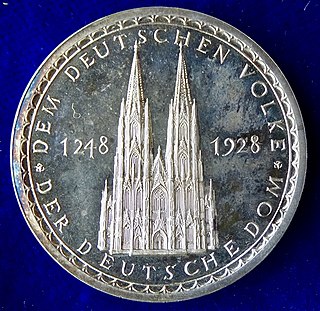
Meister or Master Gerhard was the first master mason of Cologne Cathedral. He was also known as Gerhard von Rile or by the Latin version of his name, Meister Gerardus.

Kurt Flasch is a German philosopher, who works mainly as a historian of medieval thought and of late antiquity. Flasch was professor at the Ruhr University Bochum. He was / is a member of several German and international Academies. In 2000, he was awarded the Sigmund Freud Prize by the Deutsche Akademie für Sprache und Dichtung.
Dominique Janicaud was a French philosopher, known for his critical approach to the philosophy of Heidegger. He was the director of its Center for the History of Ideas at the University of Nice Sophia Antipolis until 1998, when he was succeeded by André Tosel.
De Alchemia is an early collection of alchemical writings first published by Johannes Petreius in Nuremberg in 1541. A second edition was published in Frankfurt in 1550 by the printer Cyriacus Jacobus.

Abu al-Wafa' al-Mubashshir ibn Fatik was an Arab philosopher and scholar well versed in the mathematical sciences and also wrote on logic and medicine. He was born in Damascus but lived mainly in Egypt during the 11th century Fatimid Caliphate. He also wrote an historical chronicle of the reign of al-Mustansir Billah. However, the book he is famed for and the only one extant, Kitāb mukhtār al-ḥikam wa-maḥāsin al-kalim, the "Selected Maxims and Aphorisms", is a collection of sayings attributed to the ancient sages translated into Arabic. The date of composition given by the author is 1048–1049.

The Asclepius, also known as the Perfect Discourse, is a religio-philosophical Hermetic treatise. The original Greek text, which was likely written in Alexandria between 100 CE and 300 CE, is largely lost and only a few fragments remain. However, the full text is extant in an early Latin translation, and fragments from a Coptic translation have also been found among the documents discovered in Nag Hammadi.